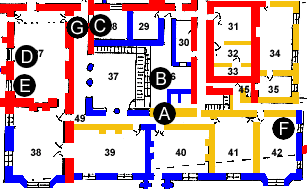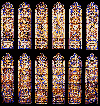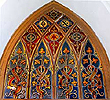|
Stained Glass on the Ground Floor
|
||
|
There are a number of stained glass windows in the house, all by William Warrington, made sometime between 1850 and 1860 during the major improvements to the fabric of the house, from the designs of John Tarning. The plan of the ground floor details the location of each window. The armorial window is the biggest and most elaborate, and would have been an extremely expensive commission by the owner Richard Cavendish, who, at the time, was in India as British Resident (Ambassador) to the Maharaja of Gwalior.
|
||
|
|
|
|
|
|
||
|
William Warrington (1796-1869) was a well-known glass painter and designer who worked for Pugin for a while. He started his workshop in 1832 and retired in 1866. Warrington and his Father were also well-known shield painters.
(Pugin was the architect of the Victorian Gothic Revival. His most famous building - with Barry - is the Houses of Parliament. Pugin also designed monumental brasses, windows and church furnishings. He fell out with Warrington because Pugin considered him too expensive. "The Glass-Painters will shorten my days, they are the greatest plague I have. The reason I did not give Warrington the window at the hospital is this. He has lately become so conceited and got nearly as expensive as Willement." - from a letter from Pugin now held at the Victoria and Albert Museum, London.) |
 |
Left are the glazier's marks of William Warrington's workshop. |
 |
||
|
|
||
|
|
||







